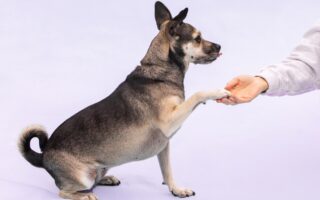Unleashing the Joy: Understanding Why Dogs Jump on People
In a world where wagging tails and floppy ears bring smiles to our faces, few canine behaviors spark as much debate as the jubilant leap of a dog onto unsuspecting humans. Whether it’s a delighted greeting or an exuberant welcome, the sudden burst of energy can leave both dog lovers and wary visitors in a state of bewilderment. For many, this enthusiastic display is a token of affection and excitement, a simple expression of a dog’s joy at being reunited with a beloved companion. Yet, for others, it can be an unexpected intrusion of fur and paws that crosses the line between playful interaction and social chaos. As we delve into the reasons behind this instinctive action, we will explore the motivations rooted in canine behavior, the impact on human relationships, and the strategies to manage this exuberance, helping to strike the perfect balance between canine enthusiasm and polite social engagement.
Table of Contents
- Understanding the Root Causes of Jumping Behavior in Dogs
- The Impact of Dog Size and Energy Levels on Social Interactions
- Effective Training Techniques to Curb Excessive Jumping
- Creating Positive Alternatives for Greeting Behavior with Dogs
- Q&A
- Concluding Remarks
Understanding the Root Causes of Jumping Behavior in Dogs
Dog jumping on people is often misunderstood, with many attributing this behavior solely to excitement or a desire for attention. However, the reality is that there are several root causes that can motivate a dog’s jumping. Anxiety is a significant factor; dogs may jump to express their nervousness or as a coping mechanism in unfamiliar situations. Additionally, social interaction needs play a crucial role. Many dogs are wired to interact with humans through physical means, and jumping can be perceived as a friendly invitation to engage. Moreover, some breeds, known for their high energy levels, may be prone to this behavior as a means of venting their pent-up energy. Understanding the underlying reasons behind this jumping can help in taking appropriate steps to mitigate the behavior.
Another important aspect to consider is the reinforcement that can inadvertently occur when dogs jump on people. If this behavior results in attention—whether positive or negative—it becomes self-rewarding. Dogs are keen observers of human reactions, and if they notice that jumping leads to any form of interaction or excitement, they are likely to repeat the behavior. A structured training approach can be beneficial in addressing this issue. Techniques such as positive reinforcement, where desired behaviors are rewarded while undesired behaviors are ignored, can cultivate better habits. It’s essential to create an environment where jumping is consistently discouraged, while simultaneously encouraging appropriate ways for dogs to greet people, such as sitting or offering a paw.
The Impact of Dog Size and Energy Levels on Social Interactions
When considering how a dog’s size and energy levels affect its interactions with people, it becomes evident that these factors play a crucial role in the way dogs engage with their environment. Larger breeds, such as Great Danes and Mastiffs, carry a different presence than smaller breeds like Chihuahuas or Pomeranians. While a large dog may inadvertently knock over a person in excitement, small dogs can be perceived as less intimidating, often leading to different social responses from those around them. The energy levels of a dog add another layer to these interactions; a hyperactive dog is more likely to leap and bound toward individuals, which can be both charming and overwhelming, depending on the circumstances.
- High-energy dogs: Often require more space and structured interaction to prevent jumping behavior.
- Low-energy dogs: Generally exhibit calm demeanor but can also be overlooked in social situations.
- Socialization needs: Varying between breeds; some need extensive interaction to temper excitement.
The dynamics of social interactions can also be influenced by how people respond to different types of dogs. A timid person might feel more comfortable around a calm, low-energy dog, reducing the likelihood of jumping incidents. In contrast, an exuberant dog paired with an equally lively owner might cultivate an energetic social environment where jumping is welcomed or even encouraged. Below is a simple table summarizing how size and energy level can affect dog interactions:
| Dog Size | Energy Level | Social Interaction Outcome |
|---|---|---|
| Small | Low | Gentle, easy to approach |
| Small | High | Playful, may jump |
| Large | Low | Calm, non-threatening |
| Large | High | Energetic, potential jumping |
Effective Training Techniques to Curb Excessive Jumping
To address the issue of dogs jumping on people, it’s crucial to implement a variety of positive reinforcement techniques during training sessions. Start by teaching your dog an alternative behavior, such as sitting or staying, when they greet guests. Use treats and praise to reward them for remaining calm and on the ground. Consider the following approaches:
- Consistent Commands: Use clear and consistent verbal cues when asking your dog to sit, ensuring everyone in the household uses the same terms.
- Practice with Friends: Organize practice sessions with friends or family who can help reinforce the training in real-life scenarios.
- Controlled Environment: Start training in a less stimulating environment and gradually introduce distractions to reinforce the learned behavior.
Another effective strategy is to manage your dog’s environment to prevent jumping incidents from occurring. This can be especially important during initial training phases. For example, prepare your home by creating a designated area where your dog can stay when guests arrive. Utilizing a simple chart can help track progress and identify patterns in your dog’s behavior:
| Date | Behavior Observed | Training Method Used | Outcome |
|---|---|---|---|
| Oct 1 | Jumping on Guests | Positive Reinforcement | Successful |
| Oct 3 | Staying Calm | Practice with Friends | Improved |
| Oct 5 | Intermittent Jumping | Consistent Commands | Needs Improvement |
By continuously adapting your approach and being patient, you will foster a more controlled greeting behavior in your dog, allowing for a more relaxed interaction with both humans and pets.
Creating Positive Alternatives for Greeting Behavior with Dogs
To effectively address the issue of dogs jumping on people, it’s essential to introduce alternatives that promote respectful and calm greetings. One effective approach is to teach dogs to sit when greeting someone. This behavior not only encourages calmness but also allows for a more controlled interaction with visitors. Consider the following steps:
- Reward Calm Behavior: Encourage your dog to remain seated when a visitor arrives, rewarding this behavior with treats and praise.
- Practice with Friends: Set up controlled scenarios with friends or family, asking them to ignore your dog until they are sitting.
- Gradually Increase Distractions: Start in quiet environments and slowly introduce more distractions, reinforcing the sit command each time.
Another alternative is using a designated “greeting spot” to redirect your dog’s energy. This area can be a mat or blanket where your dog learns to go when someone arrives. Implementing this strategy can enhance clarity for your dog. Here’s a quick overview of how to establish this behavior:
| Step | Action |
|---|---|
| 1 | Introduce the spot with positive reinforcement. |
| 2 | Use treats to encourage your dog to go to the mat when they hear a knock or doorbell. |
| 3 | Reward them for staying on the mat until they’re invited to greet. |
Q&A
Q&A: Understanding Dog Jumping Behavior
Q: Why do dogs jump on people?
A: Dogs often jump on people as a form of greeting. It’s their way of expressing excitement and affection. When they see someone they know—or even a stranger—they may leap to say hello, much like humans might wave or hug. For many dogs, it’s an instinctive behavior that stems from their puppyhood when they would nuzzle and lick their mother’s face to get attention.
Q: Is jumping a problem behavior?
A: While it can be endearing to some, jumping can quickly become problematic, especially in larger breeds or when it involves excited greetings. For the recipient, it can feel overwhelming or even dangerous. It’s important to assess the situation: if the jumping is making people uncomfortable or causing accidents, it’s time to address the behavior.
Q: How can I train my dog not to jump?
A: Training is key! Start by teaching your dog an alternative behavior, like sitting, when greeting people. Reward sitting with treats and praise. Consistency is essential: everyone who interacts with your dog should reinforce the same behavior to avoid confusion. Additionally, practice makes perfect—set up playdates with friends who can help you train your dog with controlled interactions.
Q: What should I do when my dog jumps on someone?
A: First, stay calm. If it’s someone familiar, you can redirect your dog to sit or to receive a toy instead of jumping. If your dog jumps on a stranger, gently ask them to ignore the dog until it settles down. Once the dog is calm, they can be greeted. Communicate to your guests ahead of time to approach the situation with patience and encouragement.
Q: Are certain breeds more prone to jumping?
A: Jumping behavior can occur in any breed, but it’s often seen more in energetic or social breeds like Labradors, Golden Retrievers, and Boxers. These breeds tend to have higher energy levels and a strong desire to interact with people. However, jumping can be addressed with the right training regardless of the dog’s breed.
Q: Can I embrace my dog’s jumping behavior?
A: Jumping can be a joyful expression of your dog’s personality, and in controlled environments, it may even be acceptable. If you’re okay with it, simply remind guests to be cautious. However, if it becomes a nuisance, it’s best to separate the joy of greetings from the chaos of jumping through training and behavior modification.
Q: How long does it take to train a dog to stop jumping?
A: The duration varies depending on the dog’s age, temperament, and your consistency in training. Some dogs may learn quickly, within a few weeks, while others might take several months. Patience, repetition, and a positive approach will yield the best results.
Q: Is it normal for puppies to jump?
A: Absolutely! Jumping is typical behavior for puppies as they explore and learn about their surroundings. Like all behaviors, they will grow out of it with proper training and guidance. Teaching them early on to greet people with calmness is beneficial for their development into well-mannered adults.
Q: Should I reward my dog when they stop jumping?
A: Yes! When your dog chooses not to jump, or when they follow your command to sit, be sure to reward them with treats, praise, or affection. Positive reinforcement strengthens the desired behavior and encourages your dog to replicate it in the future.
By understanding the reasons behind dog jumping and applying consistent training techniques, both dogs and their human companions can enjoy joyful and respectful greetings!
Concluding Remarks
As we explore the energetic world of our four-legged companions, it’s clear that jumping—whether in excitement, curiosity, or playful affection—is a natural behavior rooted deeply in their instincts. While it can be heartwarming to see your dog greet friends and family with boundless enthusiasm, it can also lead to unintentional chaos in social situations. Understanding why dogs jump and how to manage this behavior allows us to embrace their exuberance while fostering a sense of calm and respect.
In navigating this canine quirk, we pave the way for a more harmonious relationship with our furry friends and those around us. With patience, consistency, and positive reinforcement, we can teach our dogs to express their joy in ways that are as delightful to others as they are to us. So the next time your pup springs into the air, remember that it’s just their way of saying “hello”—and with a little guidance, we can help them find a more polite way to share their love. After all, a well-mannered dog is a happy dog, and a happy dog is a true joy to have by our side.



